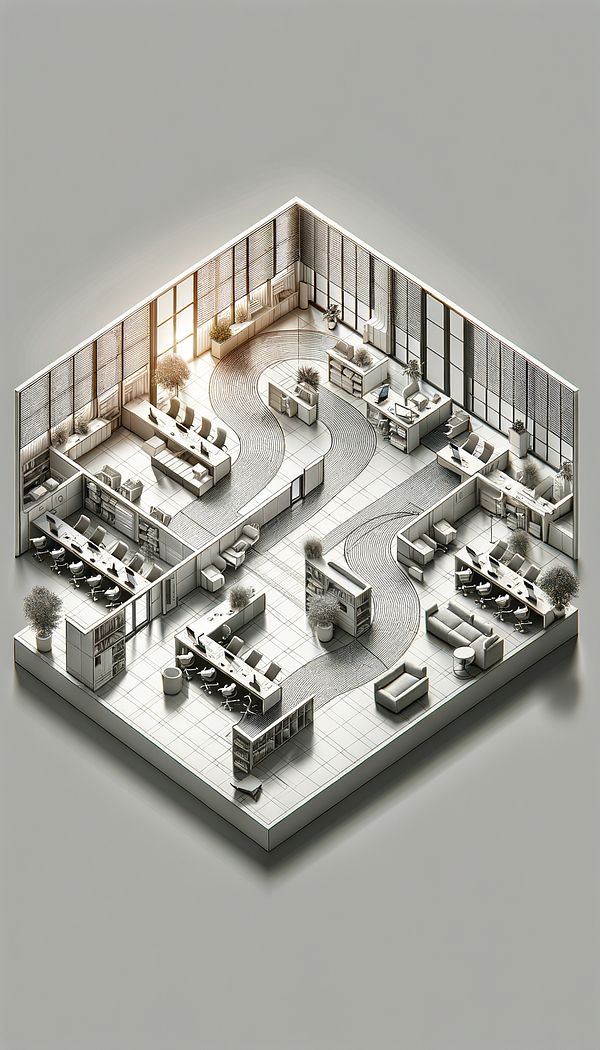What is Bidirectional Flow?
Bidirectional flow in interior design refers to the two-way movement within a space, allowing for efficient circulation and interaction.
Description
Bidirectional flow is a crucial concept in interior design, focusing on creating spaces that facilitate easy and efficient movement in two opposite directions. This principle is especially significant in areas where human traffic is high, such as commercial spaces, offices, and public buildings. By planning for bidirectional flow, designers can ensure that the space accommodates simultaneous movement without causing bottlenecks or discomfort.
The concept of bidirectional flow goes beyond mere function; it also incorporates aesthetics and the psychological impact on inhabitants. Spaces designed with this principle in mind tend to feel more open and accessible, promoting a sense of freedom and ease. Moreover, the strategic placement of furniture, pathways, and room dividers can help in guiding this flow, enhancing not just the utility but also the overall experience of the space.
Implementing a bidirectional flow often involves considerations of space planning and layout, understanding human behavior, and an in-depth knowledge of the building's usage. It is an art that balances the practical needs for movement with the desire to create welcoming, engaging environments.
Usage
In a busy corporate office, designers may implement bidirectional flow by arranging desks and communal areas in a manner that allows employees to move freely between their personal workspace and collaborative areas without congestion. Similarly, in retail settings, aisles are often designed to accommodate shoppers moving in opposite directions, facilitating comfortable browsing and efficient access to products.
FAQs
-
Why is bidirectional flow important in interior design?
Bidirectional flow is important because it ensures that spaces can handle high traffic efficiently, reducing congestion and improving the overall user experience. It also contributes to the safety, functionality, and aesthetic appeal of an environment.
-
How does bidirectional flow affect the layout of a space?
Bidirectional flow influences the layout by dictating the placement of furniture, pathways, and room dividers to promote easy and efficient movement in two opposite directions, enhancing both functionality and visual appeal.
-
Can bidirectional flow be applied to residential spaces?
Yes, while more commonly used in public and commercial spaces, bidirectional flow can also be applied to residential design. It can enhance the functionality of high-traffic areas like hallways, kitchens, and living rooms.
Practical Application
To effectively implement bidirectional flow in interior design, it is crucial to conduct a thorough analysis of the space's intended use and anticipated traffic patterns. Planning clear pathways, using room dividers wisely, and considering the placement of furniture and decor can help achieve an efficient and aesthetically pleasing design that supports bidirectional movement.
-
Decorative Objects240 articles
-
Window Treatments65 articles
-
Space Planning & Layout134 articles
-
Construction & Building86 articles
-
Flooring & Carpets48 articles
-
Corner BlockA corner block is a decorative or structural element used at the corner joints of furniture.
-
Engineered HardwoodEngineered hardwood is a type of flooring made from multiple layers of wood, including a real hardwood top layer.
-
Helical WireHelical wire is a type of wire twisted into a helix or spiral form, often used in furniture and mattress construction.
-
AgingAging, in the context of interior design, refers to a deliberate process to make an object or space appear older or more worn than it actually is.
-
Console TableA console table is a narrow, long table typically placed against a wall.
